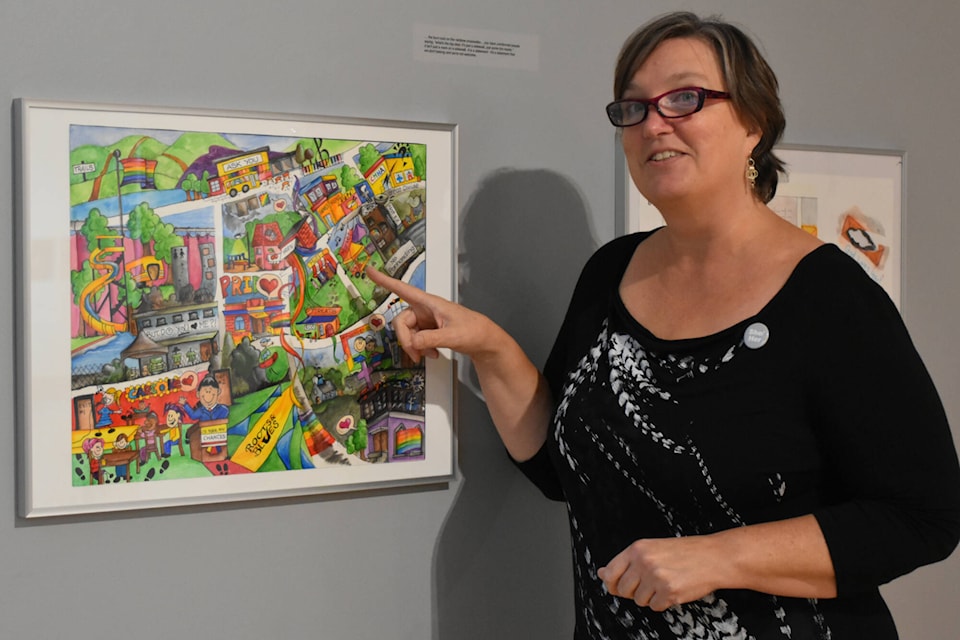The goal is pretty simple, pretty straightforward: make Salmon Arm a safe and comfortable place for everyone.
When entering ��ѻ��ý�A Place to Belong��ѻ��ý� exhibition at the Salmon Arm Art Gallery, you��ѻ��ý�ll see a large, brightly coloured quilt on one wall, along with several smaller framed creations on adjacent walls.
The smaller pieces are part of a Cultural Mapping Research Project.
Director/curator Tracey Kutschker explained that when it was decided to do an arts-based PRIDE Project designed to bring awareness and acceptance, a question arose.
��ѻ��ý�What place are we starting from?��ѻ��ý�
Kutschker and Kate Fagervik, who was then working for the arts centre, noticed a lack of information and research about 2SLGBTQ safety and wellness in Salmon Arm.
��ѻ��ý�What would be the use of having a whole festival downtown if it wasn��ѻ��ý�t a safe space for them?��ѻ��ý� asked Kutschker.
Fortunately, Fagervik had experience with cultural mapping. As well, her father, Dr. Will Garrett-Petts at Thompson Rivers University (TRU) in Kamloops, ��ѻ��ý�is basically a leader of cultural mapping training systems in the province,��ѻ��ý� Kuschker added.
He is in demand and has done cultural mapping of the opioid crisis as well as the unhoused crisis, she explained.
��ѻ��ý�So they��ѻ��ý�re all over the place doing amazing work and they were very generous with us doing this.��ѻ��ý�
She said the project, which was born three years ago, follows research protocols and strict ethics guidelines provided by TRU.
Read more:
Read more:
Over two years, the project team met with 25 participants who contributed powerful stories and maps within sessions. Participants were asked: ��ѻ��ý�As you move throughout downtown Salmon Arm, where do you feel most comfortable, and where do you feel least comfortable?��ѻ��ý�
In 2022, Garrett-Petts and graduate students returned to analyze the maps and distill the data.
One repeated finding was places that allowed for creative self-expression were deemed safe places. A couple of examples were Shuswap Theatre and the Roots and Blues festival.
��ѻ��ý�Where people feel free to do and then free to be themselves. And some places that might feel like they should be a creative space are not a safe space because they don��ѻ��ý�t allow for that open self-expression,��ѻ��ý� Kutschker explained.
Eighteen of the 25 participants, all of whom remained anonymous, agreed to show their maps at the exhibition. Along with the maps ��ѻ��ý� some containing many details with others more abstract in their art form, a transcript of an interview with each participant was made. The transcripts aren��ѻ��ý�t used in the exhibition but much of the research data is compiled from them. Excerpts from some transcripts are on the gallery walls above the maps.
One, for example, says: ��ѻ��ý�the burn outs on the rainbow crosswalks��ѻ��ý� you have uninformed people saying, ��ѻ��ý�what��ѻ��ý�s the big deal; it��ѻ��ý�s just a sidewalk, just some tire marks.��ѻ��ý� It isn��ѻ��ý�t just a mark on a sidewalk. It is a statement ��ѻ��ý� it��ѻ��ý�s a statement that we don��ѻ��ý�t belong and we��ѻ��ý�re not welcome.��ѻ��ý�
A final report is being prepared. It will be presented to city council and copies distributed to organizations such as Downtown Salmon Arm, Salmon Arm Economic Development and the Chamber of Commerce.
It won��ѻ��ý�t identify businesses.
��ѻ��ý�I think that��ѻ��ý�s a good thing because businesses can change,��ѻ��ý� said Kutschker. ��ѻ��ý�And I would never want to publish something that said, this one place is unsafe because of one individual��ѻ��ý�s bad experience with one human. That��ѻ��ý�s one thing we��ѻ��ý�ve learned. There really is no safe space, there are only safe humans.��ѻ��ý�
She is hopeful that if a business sees itself identified once or twice on the maps in the exhibition as safe and a couple of times as unsafe, it might look at what it could do better. Perhaps training staff to be more inclusive, or creating a policy about how they introduce themselves to people.
Kutschker noted what��ѻ��ý�s key is there are people who have grown up in Salmon Arm or who have lived in town for many years, and they don��ѻ��ý�t feel they belong because of how they��ѻ��ý�re treated.
She said the mapping project helps raise awareness for people who haven��ѻ��ý�t experienced the daily reality of feeling unsafe.
��ѻ��ý�All we want is for everyone to feel like Salmon Arm is their home. That��ѻ��ý�s the goal. To keep moving in that direction.��ѻ��ý�
A Place to Belong is at the art gallery Tuesday, Oct. 25 through Saturday, Oct. 29, 11 a.m. to 4 p.m, except for Thursday, open to 7 p.m.
Read more:
Read more:
martha.wickett@saobserver.net
Like us on and follow us on and subscribe to our daily .



